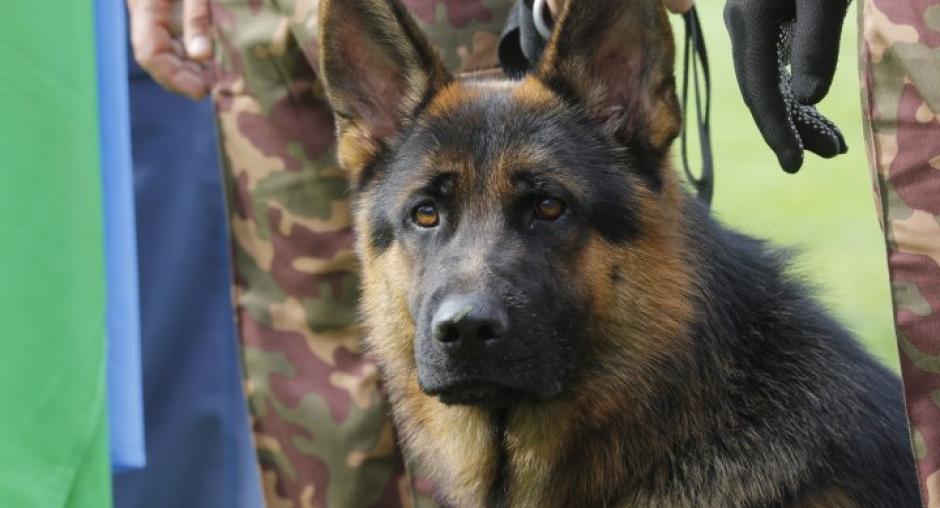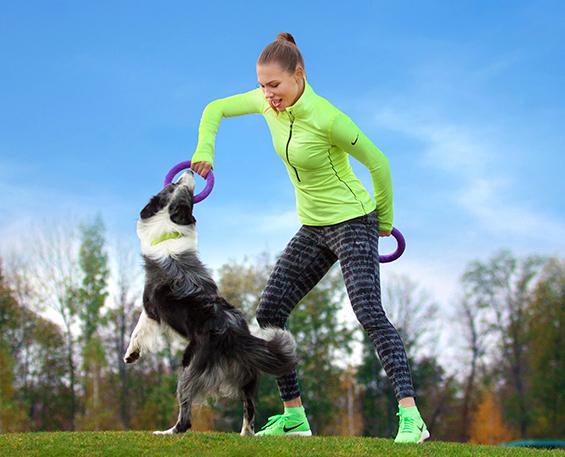If a dog is taken into the family, rules for undisturbed coexistence are absolutely necessary. Boundaries must be set so that the dog knows how to behave. It is important to properly measure the dog. Boundaries must be set consistently and lovingly without punishing the dog. Correctly correcting the dog is possible in various ways. Everything you need to know in this article.
Correct dog discipline: punishment or reward?

Proper correction of unwanted behavior is imperative to dog training. If unpleasant behaviors are not consistently combated and the dog properly reprimanded, living together becomes difficult. But this is not just a human way of doing things. Even within a dog pack, the behavior of young animals is corrected by older and higher-ranking dogs.
A correction of the behavior also takes place in the pack
Even puppies have to learn how to behave properly within the pack. If you still have freedom of fools in the first few weeks thanks to the puppy protection, the seriousness of life begins from the fourth week. The young dogs playfully explore their surroundings and already learn the first parts of dog language. If they do not behave correctly towards the older dogs, they will be reprimanded by the mother or other conspecifics.
The puppies are fixed to the ground with one paw or knocked over by the mother dog, who then sits on the pup’s body. In particularly serious violations of the pack rules, a superior dog will snout the pup’s snout. Of course without biting and hurting them. Education begins early with the mother dog.
How do I properly correct my dog?
Desired behavior is reinforced by rewards. Undesirable behavior is ignored and does not lead to success for the dog.
Сorrection by man

Through training, the dog learns to distinguish between wrong and right behavior. It is important for training not to use old methods that are mainly based on punishment and breaking the dog. Punishment is never associated with fast learning as it causes stress. Learning through rewards and reinforcement through positive signals is easier and faster.
Does desired behavior always correspond to natural dispositions?
When living with people, different behaviors are required of the dog than in the wild in a pack. Even if there is a hunting instinct, chasing other animals is not desirable.
The situation is similar with parts of dog language. Hugs, which are considered rude in dog language, must be tolerated by the dog. Direct looks do not mean aggression, but affection. Dogs must learn all of these behaviors required of owners through training.
Properly discipline the dog with a reward
Positive reinforcement is the most important method in modern dog training. Disciplining the dog properly does not mean punishing it. On the contrary: undesirable behavior is ignored, desirable behavior is rewarded.
Dog think of their advantage
Disciplining the dog properly through reward means using its natural behavior for training. Dogs have lived with humans for many centuries. In the course of living together, the four-legged friends have adapted more and more. Today, most dog breeds have a strong will to please. They try to please their caregiver. If desired behavior is then rewarded during training with food or pats, for example, the dog quickly recognizes the advantage of following rules. So the opportunism of dogs can easily be used for training.
Properly discipline the dog: sometimes punishment is necessary

It is not possible to train a dog without punishment and only by reward. Punishment does not mean chastisement or breaking the dog’s personality. In modern dog training, the punishment usually consists of a negative connection. An example situation: The puppy plays very wildly and bites the hands of the dog owner. The teeth are still small. But if the dog does not change its behavior, this has serious consequences for humans in an adult animal.
Here, the correction of the unwanted behavior takes place through punishment. The game is paused. Only when the dog calms down is it called and the game begins again. What is the dog learning? If I pinch, I can no longer play. I have to go to my seat. If I don’t pinch, i.e. behave correctly, I can continue to play with my favorite person. So the opportunistic dog no longer pinches in order not to lose the game advantage.
A method of training the mother dog
If a puppy gets too wild while playing, the mother dog will push it away with her snout. This behavior can also be used to properly discipline the dog. The puppy is chewing on a shoe: absolutely undesirable situation. He is pushed away by the human with the flat dog without violence. The game with the shoe is over. The action can also be combined with the word signal “No”. Whenever the dog chews on the shoe, it will be pushed away. At the same time, the dog receives a tasty chew as an alternative to the shoe so that the connection “Shoes are taboo” is strengthened more quickly.
How do I show my dog boundaries?
Dogs need fixed boundaries to feel safe living together. Boundaries are not indicated by prohibitions. It is better to offer the dog an alternative behavior.
Wrong and outdated methods
Dog training used to be based on absolute obedience. The individual personality of the dog was not taken into account. Orders had to be obeyed or the dog was punished.
Wrong methods in training hunting dogs

In old hunting books one often reads about false upbringing methods that appear cruel today. The dog was pulled up from a branch on a collar and leash when it failed to obey an order. The result was an uncomfortable feeling of suffocation. Today this method of education would be classified as animal cruelty, in the 19th century it was still completely normal.
Outdated methods at the dressing station
The leash and collar used to play a major role in dog training. The dog ran in circles with other dogs on a leash. The trainer standing in the center gave the command “sit”. All dogs had to sit down immediately. If the order was not obeyed, the dog owner would force the dog’s hindquarters to the ground. At Platz there was a strong tug on the leash, which tore the dog to the ground. To avoid the discomfort and pain from such treatment, after a while the dogs obeyed the commands.
Should you hit dogs?
Violence against dogs is always taboo. Beatings are always out of place in education and should be classified as animal cruelty.
Beatings and threats in education
If a dog disobeyed an order, it received a slap with the palm of the hand. Alternatively, beatings with a newspaper were threatened. What happens in this case? The dog will become afraid of the owner’s hand over time. Trust cannot be built and trust that has already been gained is lost again.
Disciplining the dog properly never has anything to do with hitting or threatening. This method is animal cruelty and only creates stress. Effective learning under stress is not possible.
With loud screaming, the dog obeys a command faster
Dogs have very sensitive hearing, with which they can easily perceive frequencies from 15 to 50,000 Hertz. When a dog doesn’t obey an order, it has its reasons. The volume at which the command is pronounced is certainly not one of them. If a dog is yelled at frequently, it will startle again and again. Over time, dogs become jaded and ignore owners’ yelling.
Punishment was the method of choice in the old days of dog training, but that is no longer the case today. Penalty consists at most of ending a game or ending the attention. If the dog is disciplined properly, corporal punishment and violence are always an absolute no-go.
Reasons for disobedience and what helps against it
Despite the best training methods, the dog may not learn or be disobedient. There are a variety of reasons for this.
Reason 1: puberty
From the fifth month the dog reaches puberty. The hormone metabolism changes and the dog becomes sexually mature. The change in hormones in the body makes it difficult for the dog to concentrate. What you have already learned has disappeared as if by magic. As in nature in a pack of dogs, the young dog is now trying to change its position in the pack and move up the hierarchy. Higher-ranking conspecifics are playfully challenged.
The young dog also applies this behavior to humans. Patience and consistency in education are particularly important now.
Reason 2: Physical causes

A dog that is deaf or hard of hearing is unable to understand and obey verbal commands. The dog may also not be able to understand the verbal command because it is too far away from its owner.
Therefore, visual signals such as hand signals should always be practiced together with the verbal signals. A hand signal can only be clearly recognized by a dog from a long distance if the hand of the dog owner moves.
Reason 3: The dog is having a bad day
Just like humans, dogs do not perform at the same level every day. Maybe the dog is tired, can’t concentrate, isn’t feeling well, or just doesn’t feel like exercising.
Now patience is required. So that the dog does not become stressed and frustrated by the failures, the training must be postponed to the next day.
To tell if the dog is enjoying the training, you should always pay attention to the dog’s body language.
Reason 4: The dog is distracted
In order for the dog to be properly disciplined, the correction of its behavior must be done in a calm environment. When too many distractions such as other dogs, toys, noises or people assail the dog, it cannot concentrate on its exercises. He is unable to study. The problem will therefore appear again.
The first basic commands should therefore be trained with puppies in a quiet place. The apartment is well suited for this. So that the dog is not distracted by objects in the apartment, it should first be completely acclimated and familiar with the new environment. If a puppy can already follow the basic commands, the exercises can also be moved outside. The exercise zone is never the right place to properly discipline a dog.
Why is the dog ignoring my commands?
The dog ignores commands if he has not understood the meaning or if following them is not advantageous for the four-legged friend. Physical causes such as deafness can also lead to ignoring the commands.
Reason 5: The dog is overwhelmed and does not understand the meaning of the command
Dogs are naturally curious and love to learn. This circumstance is not only used in dog training, but also in dog sports. So that the dog can learn the exercises more easily, they are broken down into sub-steps. Failure by the dog to obey a command during exercise does not always mean disobedience. The dog may be overwhelmed and has not yet understood the training process.
So that the dog learns faster, each exercise is broken down into the smallest possible steps. Only when one step works, the next one is tackled.
Reason 6: The dog has a mind of its own
Some dog breeds, such as beagles, dachshunds, or hounds, are harder to train than others. The dogs have their own mind and like to make decisions independently.
Correct discipline of these dogs requires consistency, patience and love in training. Once the dog has understood the meaning of a command, it will be happy to obey it.
Reason 7: The family disagrees
Dogs need boundaries and consistent commands that must also be enforced. If the members of the family do not agree on prohibitions, the dog is confused. A behavior is allowed once again and then forbidden. He no longer knows his way around and reacts with disobedience.
Before training the dog begins, all members of the family should agree on prohibitions and commands. The same command must always be used for a command in order not to confuse the dog.
Reason 8: The reward is wrong
Not every dog responds to the same reward. In order to discipline a dog properly, it is necessary to find out which rewards are of interest to him. Some dogs prefer toys, others want a treat. Some dogs wait for the owner’s affection, which can consist of stroking, a walk together or even playing together.
If the dog sees no benefit in the reward, it will continue to be disobedient. The satisfaction of disobedience is more important to the four-legged friend than the reward.
Here, the individual differences between the dogs should always be addressed. In order for the owner to be able to correct his dog, he must understand his body language and behavior exactly.
Reason 9: Humans make mistakes when correcting

Human and dog language are very different. There are misunderstandings inevitable. An example of this: The dog barks constantly. The dog owner yells at the dog. Everyone tries to outdo the others with their volume.
It is better to correct the dog through distraction. In order for him to stop barking, the four-legged friend is offered a more interesting behavior. One way to do this is with a chew. The dog relaxes by chewing and no longer vents its stress through constant barking. Of course, the distraction can also be provided by a favorite toy.





























